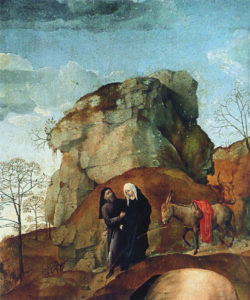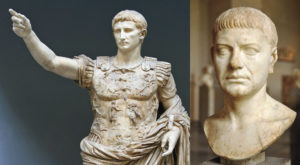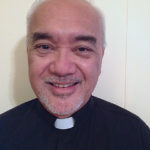The Census in Bible History
The Rev. John A.H. Tomoso†
“In those days a decree went out from Emperor Augustus that all the world should be registered. This was the first registration and was taken while Quirinius was governor of Syria. All went to their own towns to be registered. Joseph also went from the town of Nazareth in Galilee to Judea, to the city of David called Bethlehem, because he was descended from the house and family of David. He went to be registered with Mary, to whom he was engaged and who was expecting a child.” (Luke 2:1–5, NRSV)
This Gospel passage is about the Holy Family participating in a census. We see in it a journey and a process, with an authoritative and legal procedure involving everyone in a time and place. We see in this passage a duty which everyone in a locality or jurisdiction was bound by law to participate in and fulfill. Given the fact the 2020 U.S. Census is now upon us, I think it would be an empowering exercise to look at how this Gospel passage can inspire and motivate our legally prescribed participation in this year’s census.

If the Holy Family journeyed to Bethlehem which was their place of origin, can we recall where our census journey has taken us? Life is a journey that takes us from place to place, from relationship to relationship, from experience to experience. Our country is made of immigrant experiences from which we derive relationship and sense of place. Think of this year’s Census as one that nurtures all our relationships, especially those within the family. If I could access previous census records in which my family on both sides have participated in, what a story of journey they would tell.
Growing up on an island, a sense of place is easily nurtured. The Holy Family’s journey from Nazareth to Bethlehem recalls for me, our own family journeys from Kahului to Pu‘unēnē, from Ha‘ikū to Pa‘uwela, from Wailuku to Lahaina, from Kīhei to Mākena; to and from anywhere on this island and beyond, where family resided and were invited; where relationships were fostered and emotions allowed and expected to be expressed. Growing up on an island also recalls my paternal grandparents’ journey from an island far, far away—Cebu. As a child, I was regaled with stories of the hometown from which their immigrant experience as a couple began. In going to Bethlehem from Nazareth to be registered, it is noted that Mary was already “expecting a child.” My paternal grandparents probably started their family before coming here.
Moving forward to the 2020 U.S. Census, think of how all the pregnant women on our island who bring their expectancy to their participation in the 2020 U.S. Census, thus affecting and changing the numbers as the data is being counted. Jesus was born in Bethlehem during the time of the Roman Census, contributing to the change in the numbers. Think about how the births at our own Maui Memorial Medical Center will contribute to the 2020 U.S. Census with governmental thinking and action in a way like that of Roman Government thinking and action at the time of Jesus’ birth!

In this time and place on Maui, with immigration policy thrust into the limelight, the 2020 U.S. Census is a social, political, economic, educational and environmental barometer, so to speak, of how further government policies and action will unfold. Certainly, the “immigration” of the Holy Family to Bethlehem caused government policy and action to unfold.
Undoubtedly, at the conclusion of the 2020 U.S. Census, there will be social, political, educational and environmental changes in our shared civic life, both quantitative and qualitative. The Gospel words “there was no place for them in the inn” causes one to ponder how to come up with a solution to the current homeless population in our midst. The time for the Census in this place of Maui has a solution, many solutions embedded in its process and procedure. Growing up on Maui, I don’t remember seeing homeless folk on the roads. Perhaps they were hidden. But the fact that I never saw any probably meant that there were places for them to be. Remembering that Jesus was born in a stable, I pray that in this time and current place of Maui, there are places for all of us to be housed, to be fed, to be nurtured, to be loved.
It has been estimated that the Holy Family’s journey from Nazareth to Bethlehem, their journey to “be registered” (counted) took about 10 days. The 2020 U.S. Census has a beginning and an end. The Gospel records that the Roman Census at the time of Jesus’ birth was basically about taxation. The 2020 U.S. Census is about so much more, including information and data that can and will affect the churches and faith communities around us. The historical record of the Roman Census probably confirms that the Gospel writer of Luke had erroneously put it at the birth of Jesus. Nonetheless, the decision Joseph made to return to the family home in Bethlehem was about having his newly betrothed wife Mary being able to give birth within familiar surroundings, with family members around. I think that all Census processes and procedures are really about family and how it is important to have family around and to know that they are safe and nurtured and capacitated to live a life worthy of its giftedness by God. May the 2020 U.S. Census be for you and your family, a journey of investment of care and concern of those you love, up close and personal!
 Rev. John A. Hau’oli Tomoso† is a Social Worker and Episcopal Priest. He is a Priest Associate at Good Shepherd Episcopal Church in Wailuku and an on-call Chaplain at Maui Memorial Medical Center. Tomoso was graduated from St. Anthony Jr./Sr. High School, the College of St. Thomas in St. Paul, Minnesota (Bachelor of Arts in Political Science and Sociology) and Myron B. Thompson School of Social Work at the University of Hawai’i at Mānoa (Masters of Social Work). In 2008, he retired from the civil service as the Maui County Executive on Aging. In March 2019, Tomoso retired as the Executive Director of the non-profit Tri-Isle Resource Conservation and Development Council, Inc., after a social work career that spanned 43 years of practice. His wife Susan recently retired as a 7th grade Language Arts Teacher at Maui Waena Intermediate School.
Rev. John A. Hau’oli Tomoso† is a Social Worker and Episcopal Priest. He is a Priest Associate at Good Shepherd Episcopal Church in Wailuku and an on-call Chaplain at Maui Memorial Medical Center. Tomoso was graduated from St. Anthony Jr./Sr. High School, the College of St. Thomas in St. Paul, Minnesota (Bachelor of Arts in Political Science and Sociology) and Myron B. Thompson School of Social Work at the University of Hawai’i at Mānoa (Masters of Social Work). In 2008, he retired from the civil service as the Maui County Executive on Aging. In March 2019, Tomoso retired as the Executive Director of the non-profit Tri-Isle Resource Conservation and Development Council, Inc., after a social work career that spanned 43 years of practice. His wife Susan recently retired as a 7th grade Language Arts Teacher at Maui Waena Intermediate School.
